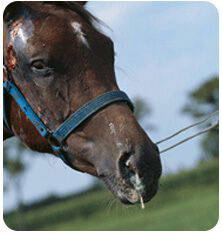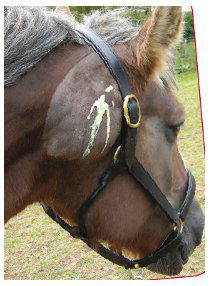
The Disease Strangles is a commonly diagnosed infectious disease that affects all equidae worldwide. Caused by the bacterium Streptococcus equi (S.equi), this disease is highly contagious and is spread by direct or indirect contact. It can affect any age, sex or breed of horse and remains a widely feared disease because of its debilitating effects and its potential economic impact on equestrian businesses.
Spread the word…not the disease!
There is no legal requirement to notify the authorities about an outbreak of strangles, but affected establishments are strongly encouraged to advise neighbouring equine premises of an outbreak to reduce the risk of spread. The vast majority of strangles outbreaks are simply down to bad luck rather than bad management and there should be no stigma attached to an outbreak. Rather than remain silent, being open and honest about an outbreak will help to reduce the spread of the disease.
Clinical signs
The severity and number of clinical signs exhibited can vary between individual horses. Young, elderly and debilitated horses are often most susceptible but it is important to remember all horses are at risk. Clinical signs are not usually seen until 3-14 days after the horse has been in contact with the bacterium.
Strangles Clinical signs include:
- Depression and dullness
- Loss of appetite
- Nasal discharge
- Development of a cough
- High temperature
- Swelling of the lymph nodes (glands) under the jaw or on the head or neck which can lead to abscess formation at a later stage
IT IS IMPORTANT TO REMEMBER THAT HORSES CAN START TO SPREAD THE DISEASE BEFORE THE CLINICAL SIGNS APPEAR
The abscesses which cause the lymph nodes to swell often burst discharging highly infectious, thick creamy-yellow pus. In some cases the glands swell so much they restrict the airway hence the name strangles. Atypical strangles is now commonly recognised whereby infected horses display minor or no clinical signs. The infected horse may exhibit a mild respiratory infection but no abscesses develop. As a result strangles can be overlooked as the symptoms displayed are common clinical signs for other diseases. In a very small number of cases the infection spreads causing abscesses to form in lymph nodes and organs around the body. This condition, known as bastard strangles, is potentially fatal. Another less common complication, purpura haemorrhagica, causes bleeding into the gums, skin and organs such as the lungs and can be fatal.
In approximately 10 percent of cases infected horses become carriers even though they themselves have recovered and appear healthy. Carriers have become persistently infected when abscess material forms in the guttural pouches (air sacs in the back of the throat) of the horse and is not completely eliminated. The bacteria can survive in the guttural pouch for months or even years. Carriers can, therefore, continue to spread the disease causing new outbreaks if the horse becomes stressed, for instance moving to a new yard. IF YOU HAVE ANY CONCERNS FOR YOUR HORSE’S HEALTH CONTACT YOUR VET
Spread of infection
Strangles can be spread easily by direct contact between horses or indirectly by handlers, equipment or contamination of the environment. This can lead to large outbreaks with many horses becoming infected if strict biosecurity measures are not put in place and adhered to. For example, the infection can be spread:
- by nose to nose contact between horses
- via equipment shared with infected horses, such as:
- water troughs where the bacterium can survive for long periods
- feed buckets
- grooming equipment
- tack
The mixing of horses from different areas, such as when at a show and new arrivals to a yard, increases the risk of disease being spread. Outwardly healthy horses are often overlooked as not being a risk but it is important to remember:
- A horse may be infected but not yet showing any clinical signs
- A horse may have atypical strangles
- Carriers can intermittently shed the bacteria for months or years
- Horses not yet fully recovered from the disease can still shed the bacteria
Isolation
All infected or suspect horses should be isolated immediately, including any other horse(s) they have been in contact with. Isolation plays an important role in preventing further disease spread. The ‘Strategy to Eradicate and Prevent Strangles (STEPS)’ provides detailed information on isolation procedures; to download a copy visit the BHS website.
Diagnosis
There are currently three tests available which can be carried out by your veterinary surgeon:
1 A blood test.
2 Guttural pouch endoscopy including bacteriological analysis of guttural pouch washes.
3 A series of three clear nasopharyngeal swabs, taken at weekly intervals, testing for the presence of the bacterium.
Strangles Blood Test
A blood test developed by the Animal Health Trust (AHT) is available to help identify the presence of antibodies to S.equi in the horse’s bloodstream. As the test requires only one blood sample, it is easier and more convenient for veterinarians to routinely screen horses prior to movement, competition or sales.
The blood test can identify:
- horses that are currently affected
- horses that have been infected with strangles in the last six months and have recovered
- horses that have been previously infected and have become carriers.
An important limitation of the blood test is that it takes approximately two weeks for a horse to develop antibodies against S.equi and so it may not be possible to accurately identify horses in the very early stages of the disease. The test is particularly useful as a screening tool prior to movement, introduction of a horse into a new herd and in the identification of potential carriers at the end of a strangles outbreak. The blood test provides a rapid diagnosis as the results can be obtained within 24 hours. If the test is positive further tests are then required to confirm if the horse is recovering from the disease or if they are a carrier
Treatment
Each case of strangles should be individually discussed with the attending veterinary surgeon to decide the most appropriate treatment for the infected horses. Most affected horses recover uneventfully over a period of a few weeks in combination with strict biosecurity measures. Treatment is available for carriers to remove the persistent infection. Once the material is removed these horses can continue to lead healthy lives and no longer pose an infection threat to other horses.
Credit: British Horse Society
Search
Recent Articles
Categories
- Advice Hub
- Athlete
- Carriage Driving
- Dentistry
- Dressage
- Endurance
- Eventing
- Farrier
- Featured
- Featured Horse Ads
- Featured Posts
- Horse Racing
- Horse's Mouth
- Horseball
- Hunting
- Le Trec
- Leisure Riders
- Mounted Games
- Nutrition
- Polo
- Polocrosse
- Reining
- Rescue & Rehabilitation
- Show Jumping
- Showing
- Tack Room
- Team Chasing
- The Pony Club
- Therapy
- Training
- Vaulting
- Veterinary





